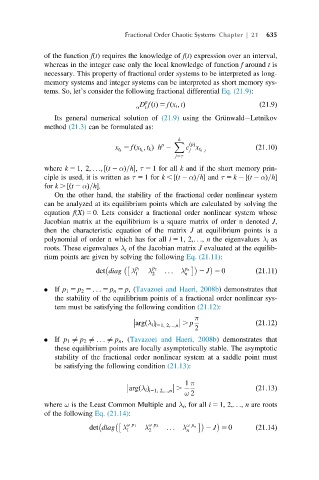Page 664 - Mathematical Techniques of Fractional Order Systems
P. 664
Fractional Order Chaotic Systems Chapter | 21 635
of the function f(t) requires the knowledge of f(t) expression over an interval,
whereas in the integer case only the local knowledge of function f around t is
necessary. This property of fractional order systems to be interpreted as long-
memory systems and integer systems can be interpreted as short memory sys-
tems. So, let’s consider the following fractional differential Eq. (21.9):
p
α D fðtÞ 5 fðx t ; tÞ ð21:9Þ
t
Its general numerical solution of (21.9) using the Gru ¨nwald Letnikov
method (21.3) can be formulated as:
k
X
p
; t k Þ h 2 ðpÞ
j
x t k 5 fðx t k c x t k2j ð21:10Þ
j5τ
where k 5 1; 2; ...; ½ðt 2 αÞ=h; τ 5 1 for all k and if the short memory prin-
ciple is used, it is written as τ 5 1 for k , ½ðt 2 αÞ=h and τ 5 k 2 ½ðt 2 αÞ=h
for k . ½ðt 2 αÞ=h.
On the other hand, the stability of the fractional order nonlinear system
can be analyzed at its equilibrium points which are calculated by solving the
equation f(X) 5 0. Lets consider a fractional order nonlinear system whose
Jacobian matrix at the equilibrium is a square matrix of order n denoted J,
then the characteristic equation of the matrix J at equilibrium points is a
polynomial of order n which has for all i 5 1, 2,..., n the eigenvalues λ i as
roots. These eigenvalues λ i of the Jacobian matrix J evaluated at the equilib-
rium points are given by solving the following Eq. (21.11):
p 1 p 2
det diag λ λ .. . λ p n 2 J 5 0 ð21:11Þ
1 2 n
If p 1 5 p 2 5 ... 5 p n 5 p; (Tavazoei and Haeri, 2008b) demonstrates that
the stability of the equilibrium points of a fractional order nonlinear sys-
tem must be satisfying the following condition (21.12):
π
ðÞ . p ð21:12Þ
arg λ i i51; 2;...;n
2
If p 1 6¼ p 2 6¼ ... 6¼ p n ; (Tavazoei and Haeri, 2008b) demonstrates that
these equilibrium points are locally asymptotically stable. The asymptotic
stability of the fractional order nonlinear system at a saddle point must
be satisfying the following condition (21.13):
1 π
ðÞ . ð21:13Þ
arg λ i i51; 2;...;n
ω 2
where ω is the Least Common Multiple and λ i , for all i 5 1, 2,.. ., n are roots
of the following Eq. (21.14):
ω p 1 ω p 2
det diag λ λ ... λ ω p n 2 J 5 0 ð21:14Þ
1 2 n

